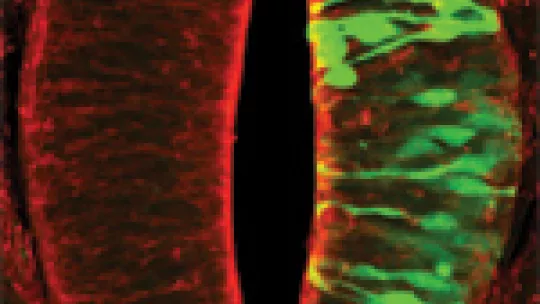Images
Scientists will use it to analyse the stress responses used by cells to solve genomic errors, and also to identify targets of therapeutic interest.
When cells accumulate excessive errors in the proteins they produce, apoptosis is activated, that is to say, a cell suicide programme; however, beforehand the cells attempt to rectify the problem through a number of rescue responses. Scientists know only the general outline of the mechanisms behind cellular “stress responses”, the interactions between them and the molecular components involved. Researchers at the Institute for Research in Biomedicine (IRB Barcelona) have designed a new tool to study rescue signalling pathways and cell suicide in depth. A description of this method has been published in the last issue of the specialized Journal Nucleic Acids Research, included in the group Oxford Journals.
“We have developed a strategy to induce controlled mutations in the cell, which allows us to gradually activate several repair systems that are triggered before the cell enters the cell death programme. Using previous methods, the effects on cells are less specific and may lead to parallel responses that hinder analysis of the results”, explains the author of the article, Lluís Ribas de Pouplana, ICREA researcher and head of the Gene Translation Laboratory at IRB Barcelona.
Ribas: “We have developed a strategy to induce controlled mutations in the cell, which allows us to gradually activate several repair systems that are triggered before the cell enters the cell death programme.”
Traditional techniques consist of exposing the cells to drug or compounds that affect protein production, thereby creating instability. Renaud Geslain, a researcher in Ribas’ group and first author of the article, “had a brilliant idea to reproduce the same effect within the cell, without the help of compounds alien to the cell”, recalls Ribas. Geslain manipulated a component of the cellular protein synthesis machinery that causes the production of defective proteins. “In response to the accumulation of misfolded proteins, the cellular alarm systems are switched on and stress responses are activated. Given that this approach affects all the proteins, we obtain all the reactions possible, not only responses that could be exclusive to one or a few affected proteins”.
How to interfere with protein production?
Cells are bags full of proteins and all proteins are formed by large chains of amino acids. Cells continually make these molecules through a highly complex system. One of the components involved in protein production, a process in which the Gene Translation Lab is specialized, is transfer RNA (tRNA). The function of tRNA is to transport the protein synthesis machinery and the precise amino acids required for each protein under construction. Geslain designed new tRNAs, very similar to natural ones, but that place erroneous amino acids into the protein sequences under construction. “When these tRNAs are introduced, the cells starts to make and accumulate defective proteins and it reacts in response. Given that the cell still conserves the healthy proteins present before the introduction of our tRNA, we can observe the extent to which the healthy part can correct the problem. We can also see when these defects are no longer correctible and how and when cells enter the suicide programme.”
The researchers know which modification they introduce into the protein synthesis system and can measure the cellular responses to the error produced. More serious mutations can trigger cell suicide in less than 48 hours, while less severe ones allow the cell to survive for 5 days. “Thus we can observe the whole spectra of cell responses triggered and measure when they begin and the connections between them. Finally, by means of transcriptomics studies, we can identify new components involved in this process”, explains Ribas.
The lab has started to obtain results using this new tool. Analyses indicate that part of the cell response to the accumulation of misfolded proteins is the production of several micro-RNAs, small molecules that regulate gene expression. “We still don’t know what they do or what genes they repress but we are discovering very surprising functional connections”, notes the IRB Barcelona researcher.
Besides, Ribas continues, “the biological problem that we induce in the cell is directly linked to neurodegenerative diseases such as Alzheimer’s, Parkinson’s and Huntington’s, which are caused by the aggregations of misfolded proteins that cause neuronal death”. The tool developed at IRB Barcelona will allow the identification of new components of the response mechanisms to these mutations. In the future, these components may become targets for intervention in these and other diseases.
Reference article:
Chimeric tRNAs as tools to induce proteome damage and identify components of stress responses
Renaud Geslain; Laia Cubells; Teresa Bori-Sanz; Roberto Alvarez-Medina; David Rossell; Elisa Marti; Lluis Ribas de Pouplana
Nucleic Acids Research 2009; doi: 10.1093/nar/gkp1083
About IRB Barcelona
The Institute for Research in Biomedicine (IRB Barcelona) pursues a society free of disease. To this end, it conducts multidisciplinary research of excellence to cure cancer and other diseases linked to ageing. It establishes technology transfer agreements with the pharmaceutical industry and major hospitals to bring research results closer to society, and organises a range of science outreach activities to engage the public in an open dialogue. IRB Barcelona is an international centre that hosts 400 researchers and more than 30 nationalities. Recognised as a Severo Ochoa Centre of Excellence since 2011, IRB Barcelona is a CERCA centre and member of the Barcelona Institute of Science and Technology (BIST).





